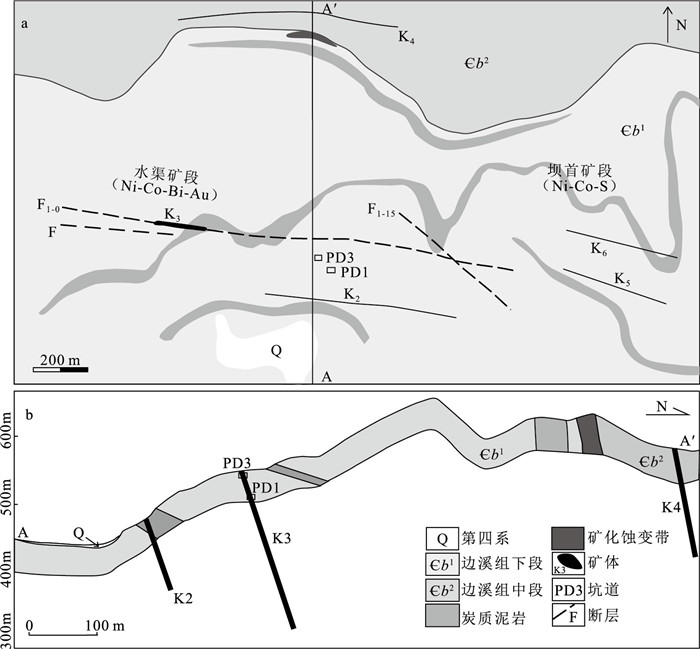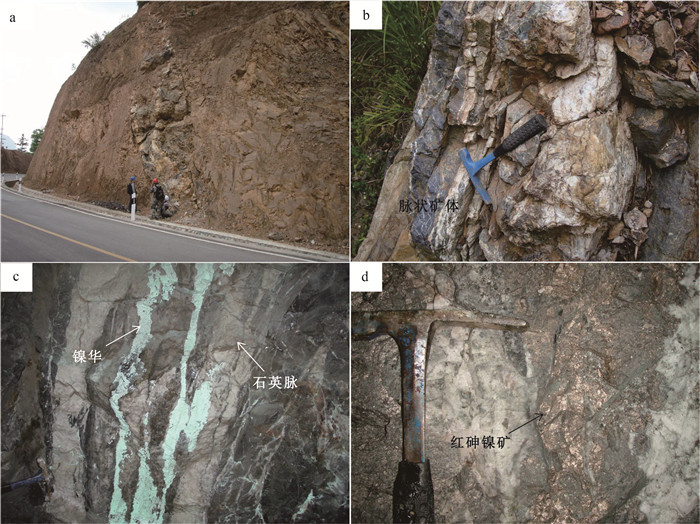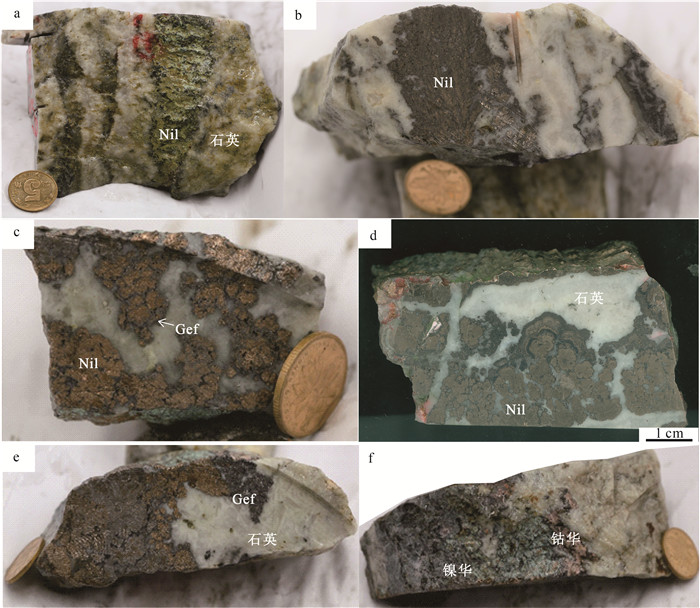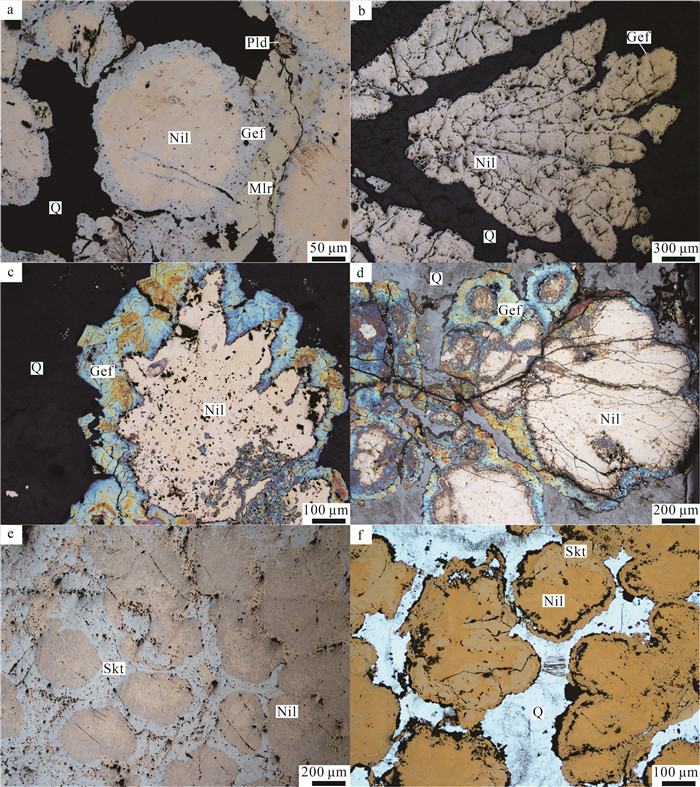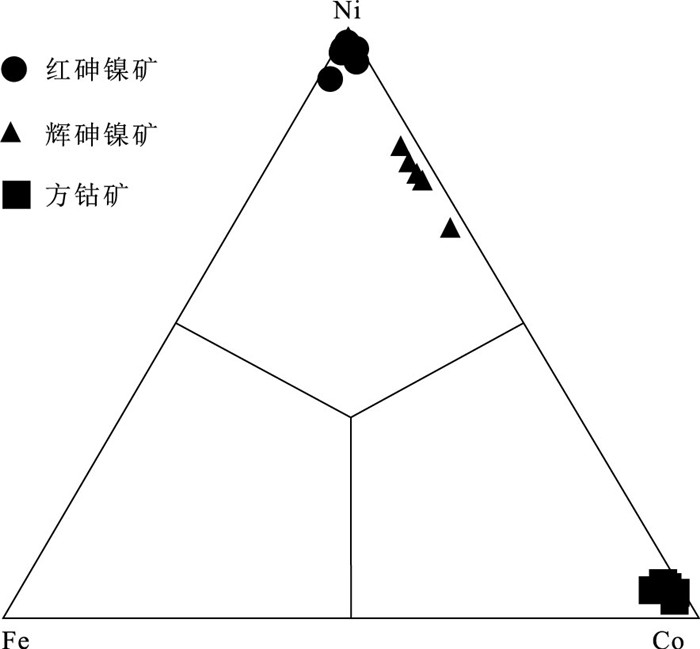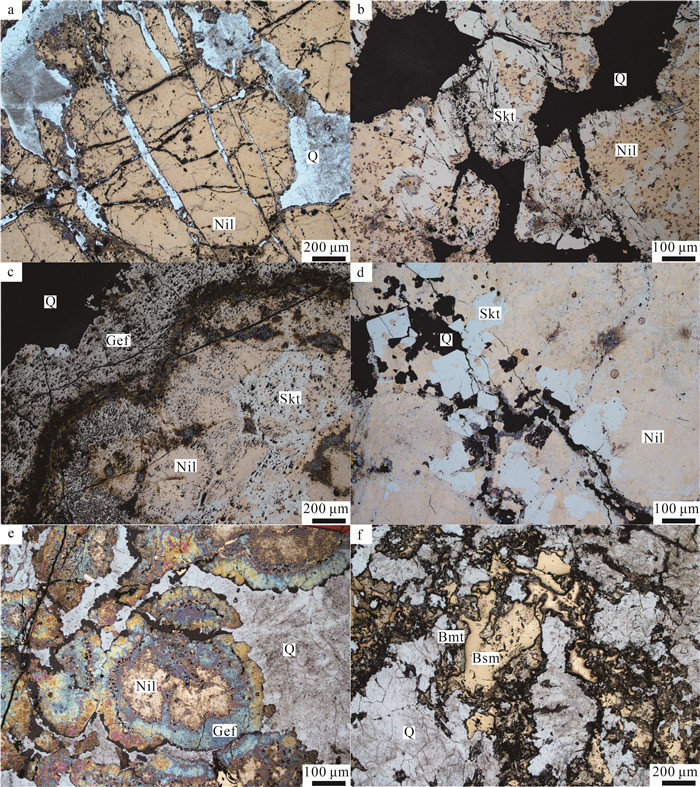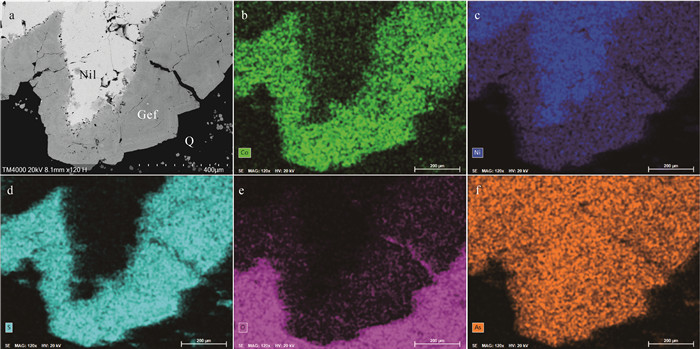The supernormal enrichment regularity and metallogenic conditions of hydrothermal vein-type nickel-cobalt ore deposit in the Cambrian black rock series of Jinxiu, Guangxi, South China
-
摘要:
在华南地区的广西金秀寒武系黑色岩系中发现了热液脉状镍钴矿床,矿石品位超常富集,元素组合特殊,实属罕见,具有重要的科学价值和找矿意义。本文介绍龙华矿床的地质特征和矿石富集规律,以及矿物学和地球化学初步研究成果。含矿围岩是寒武系清溪组下段炭质泥岩,矿体可分为高品位热液脉状和低品位浸染状2类。主矿脉中出现镍-钴-砷和镍-钴-硫两类矿物组合,且两者呈分离状态,分别赋存在NWW向和NNW向断裂构造中。矿石成分主要是镍-钴砷化物、少量硫化物,以及石英和碳酸盐。采用电子探针方法分析了红砷镍矿、辉砷镍矿、硫镍矿、针镍矿、方钴矿、辉铋矿和自然铋矿物的元素含量,讨论了主要矿石矿物的Fe-Co-Ni三元图解。根据矿物内部结构构造和共生关系,厘清了矿物生成顺序,将矿石矿物的形成过程划分为内生热液作用期和表生作用期。元素面扫描分析结果表明,红砷镍矿内部Ni、Co、S元素具有显著的分带特征,可能是二次生长的结果。热液脉状镍钴矿床可能是加里东运动以前的古老地壳物质再循环的产物,花岗岩体与成矿作用的关系尚难评判,Ni-Co元素的超常富集可能主要来自于后期的构造-流体改造作用。
Abstract:A hydrothermal vein-type nickel-cobalt deposit was discovered in the Cambrian black rock series in Jinxiu, Guangxi, South China.The deposit is exceptionally rare and holds significant scientific and prospecting importance.This paper introduces the geological characteristics of the Longhua deposit, the rules governing ore enrichment, as well as mineralogical and geochemical investigations.The ore-bearing rock is carbonaceous mudstone in the lower part of the Cambrian Qingxi Formation, and the ore-bodies can be classified into two types: high-grade hydrothermal veins and low-grade disseminated types.Two main mineral assemblages are identified: Ni-Co-As and Ni-Co-S, occurring within the primary vein.Their distribution aligns with NWW and NNW trending faults, respectively.The primary ore minerals consist of Ni-Co arsenide, accompanied by a minor presence of sulfide, quartz and carbonate.Elemental contents of niccolite, gersdorffite, polydymite, millerite, skutterudite, bismuthite, and native bismuth minerals were analyzed using the electron probe method.Additionally, the Fe-Co-Ni ternary diagram of the primary ore minerals was examined.Based on the internal structure and paragenetic relationships of minerals, the sequence of mineral formation is elucidated, and the formation process of ore minerals can be divided into endogenic hydrothermal stage and epigenetic stage.The results of elemental mapping analysis reveal significant zonation characteristics in Ni, Co, and S elements within niccolite, possibly indicating secondary growth as the underlying cause.The hydrothermal vein-type nickel-cobalt deposit may be the product of the old crustal material recirculation before Caledonian Movement. The relationship between granites and mineralization is still difficult to judge. The supernormal enrichment of nickel-cobalt elements may mainly come from the late tectonic-fluid reformation.
-

-
图 1 龙华镍-钴矿床位置图(据Li et al., 2017修改)
Figure 1.
图 2 龙华镍-钴矿区地质平面图(a)与A-A′典型剖面(b) (据中国有色桂林矿产地质研究院有限公司,2016修改)
Figure 2.
表 1 龙华矿区PD3和PD1坑道中3号矿体矿石分析结果
Table 1. Analytical result of ores from PD1 and PD3 tunnels of No.3 ore zone in Longhua deposit
样号 坑道 位置 Ni/% Co/% Cu/% As/% Bi/% Au/10-6 PD3-H1-2 PD3 3号矿体 18.93 2.76 0.0015 X荧光法分析,12.72%~ 36.46%,平均为28.47% 0.96 PD3-H2-2 3号矿体 21.65 0.73 0.0015 0.03 PD3-H3-2 3号矿体 19.62 0.80 0.0015 0.044 PD3-H4-2 3号矿体 6.16 1.44 0.0014 0.092 PD3-H5-2 3号矿体 14.51 1.52 0.0022 0.41 P1 PD1 沿脉矿石 0.99 1.52 3.44 6.25 P2 沿脉矿石 0.15 P4 沿脉矿石 0.097 0.49 P5 沿脉矿石 0.28 0.15 6.77 P6 沿脉矿石 0.12 0.52 注:据中国有色桂林矿产地质研究院有限公司,2016。分析方法:Ni、Co、Cu为发射光谱法,As、Bi、Au为等离子体质谱(ICP-MS)测试方法 表 2 龙华矿区3号矿体近矿围岩和石英脉分析结果
Table 2. Analytical result of country rock and quartz vein of No.3 ore zone in Longhua deposit
样号 名称 Ni/% Co/% Cu/% Au/10-6 PD3-H1-1 硅化砂岩 0.10 0.032 0.018 0.0056 PD3-H1-3 硅化砂岩 0.29 0.054 0.034 0.0064 PD3-H2-1 硅化砂岩 0.24 0.034 0.060 0.0072 PD3-H2-3 硅化砂岩 0.11 0.029 0.011 0.0070 PD3-H3-1 硅化砂岩 0.062 0.0054 0.0051 0.0078 PD3-H3-3 硅化砂岩 0.085 0.013 0.0082 0.0054 PD3-H4-1 硅化砂岩 0.050 0.026 0.0026 0.0062 PD3-H4-3 硅化砂岩 0.087 0.0076 0.010 0.011 PD3-H5-1 硅化砂岩 0.58 0.056 0.0010 0.0098 PD3-H5-3 硅化砂岩 0.018 0.0064 0.0020 0.013 PD3-H0 石英脉 0.015 0.011 0.0026 0.0078 PD3-H6-1 硅化砂岩 0.016 0.0048 0.034 0.0076 PD3-H6-2 石英脉 0.025 0.0034 0.024 0.0082 PD3-H7-1 硅化砂岩 0.13 0.10 0.049 0.032 PD3-H7-2 矿化石英脉 0.20 0.13 0.022 0.16 PD3-H7-3 硅化砂岩 0.010 0.0095 0.0044 0.0084 注:据中国有色桂林矿产地质研究院有限公司,2016;分析方法:Ni、Co、Cu为发射光谱法,Au为等离子体质谱(ICP-MS)测试方法 表 3 主要矿石矿物电子探针数据
Table 3. EPMA analyses of the major ore minerals from the Longhua deposit
矿物 红砷镍矿 硫镍矿 自然铋 辉铋矿 标号 1-2-1 1-2-4 2-1-4 2-1-5 7-1-2 7-1-3 1-4-1 1-4-5 1-2-2 1-2-5 1-4-2 2-3-4 As 52.94 53.32 54.83 55.15 52.45 54.17 54.52 53.89 0.73 0 0 0.17 Ni 44.51 44.18 44.28 44.78 37.87 40.26 44.41 44.79 45.73 0.63 0.63 0.18 S 0.35 0.56 0.03 0.04 3.10 2.18 0.43 0.30 39.96 1.13 0.51 18.54 Co 0.20 0.33 0.10 0.14 0.22 3.78 0.21 0.19 0.46 0 0 0.1 Fe 0.04 0.05 0.01 0.05 5.41 0.10 0.04 0 7.90 0.19 0.32 0.18 Bi 0.02 0.16 0.32 0 0.27 0 0 0.08 0.76 93.83 98.54 74.09 Sb 0.67 0.76 0.02 0.15 0.18 0.16 0.72 0.81 0.07 0 0 0.31 总计 98.73 99.36 99.59 100.31 99.50 100.65 100.33 100.06 95.61 95.78 100.00 93.57 矿物 辉砷镍矿 方钴矿 针镍矿 标号 2-1-1 2-1-2 2-1-3 1-4-4 1-4-6 7-1-1 7-1-4 7-1-5 4-2-2 4-2-3 1-2-3 1-4-7 As 44.97 45.41 47.65 44.42 45.05 81.20 82.04 81.60 81.22 81.45 2.78 2.919 Ni 25.91 26.66 28.66 26.30 21.50 0.77 1.00 1.01 0.98 0.96 44.62 44.36 S 16.08 15.65 14.66 19.53 19.60 0.14 0.14 0.11 0.14 0.12 22.83 23.17 Co 7.95 7.17 4.85 8.61 13.57 20.41 20.32 20.35 20.36 20.42 0.03 0.06 Fe 0.42 0.69 0.57 1.06 0.90 0.51 0.55 0.52 0.52 0.51 2.17 2.61 Bi 0.52 0.02 0.13 0.22 0 0.14 0.15 0 0.12 0.15 28.37 26.83 Sb 0.21 0.26 0.15 0.34 0.13 0 0 0 0 0 0.49 1.20 总计 96.06 95.86 96.67 100.48 100.75 103.17 104.20 103.59 103.34 103.61 101.29 101.15 表 4 矿石矿物生成序列
Table 4. Paragenetic sequence of ore minerals in the Longhua deposit
矿物 热液作用期 表生作用期 红砷镍矿 
方钴矿 
辉砷镍矿 
辉铋矿 
自然铋 
针镍矿 
硫镍矿 
石英 
镍华 
钴华 
-
[1] Ahmed A H, Arai S, Ikenne M. Mineralogy and paragenesis of the Co-Ni arsenide ores of Bou Azzer, Anti-Atlas, Morocco[J]. Economic Geology, 2009, 104(2) : 249-266. doi: 10.2113/gsecongeo.104.2.249
[2] Boström K. Genesis of ferromanganese deposits-diagnostic criteria for recent and old deposits[C]// Rona P A, Boström K, Laubier L, et al. Hydrothermal Processes at Seafloor Spreading Centers. New York: Springer, 1983: 473-483.
[3] Cao J, Hu K, Zhou J, et al. Organic clots and their differential accumulation of Ni and Mo within early Cambrian black-shale-hosted polymetallic Ni-Mo deposits, Zunyi, South China[J]. Journal of Asian Earth Sciences, 2013, 62: 531-536. doi: 10.1016/j.jseaes.2012.11.002
[4] Coveney R M, Chen N S. Ni-Mo-PGE-Au-rich ores in Chinese black shales and speculations on possible analogues in the United States[J]. Mineralium Deposita, 1991, 26(2) : 83-88. doi: 10.1007/BF00195253
[5] Coveney R M, Pašava J. Diverse connections between ores and organic matter[J]. Ore Geology Reviews, 2004, 24(1/2) : 1-5.
[6] Cui M M, Su B X, Wang J, et al. Linking selective alteration, mineral compositional zonation and sulfide melt emplacement in orogenic-type magmatic Ni-Cu sulfide deposits[J]. Journal of Petrology, 2022, 63(6) : egac043. doi: 10.1093/petrology/egac043
[7] Feng C Y, Zhang D Q. Cobalt deposits of China: Classification, distribution and major advances[J]. Acta Geologica Sinica, 2004, 78(2) : 352-357. doi: 10.1111/j.1755-6724.2004.tb00139.x
[8] Hitzman M W, Bookstrom A A, Slack J F, et al. Cobalt—styles of deposits and the search for primary deposits[M]. Reston, VA: U.S. Geological Survey, 2017.
[9] Horn S, Gunn A G, Petavratzi E, et al. Cobalt resources in Europe and the potential for new discoveries[J]. Ore Geology Reviews, 2021, 130: 103915. doi: 10.1016/j.oregeorev.2020.103915
[10] Huang W T, Wu J, Liang H Y, et al. Geology, Geochemistry and genesis of the Longhua low-temperature hydrothermal Ni-Co arsenide deposit in sedimentary rocks, Guangxi, South China[J]. Ore Geology Reviews, 2020, 120: 103393. doi: 10.1016/j.oregeorev.2020.103393
[11] Jiang S Y, Chen Y Q, Ling H F, et al. Trace- and rare-earth element geochemistry and Pb-Pb dating of black shales and intercalated Ni-Mo-PGE-Au sulfide ores in Lower Cambrian strata, Yangtze platform, South China[J]. Mineralium Deposita, 2006, 41(5) : 453-467. doi: 10.1007/s00126-006-0066-6
[12] Jiang S Y, Yang J H, Ling H F, et al. Extreme enrichment of polymetallic Ni-Mo-PGE-Au in Lower Cambrian black shales of South China: An Os isotope and PGE geochemical investigation[J]. Palaeogeography, Palaeoclimatology, Palaeoecology, 2007, 254(1/2) : 217-228.
[13] Kříbek B, Sykorová I, Pašava J, et al. Organic geochemistry and petrology of barren and Mo-Ni-PGE mineralized marine black shales of the Lower Cambrian Niutitang Formation(South China) [J]. International Journal of Coal Geology, 2007, 72(3/4) : 240-256.
[14] Lehmann B, Frei R, Xu L G, et al. Early Cambrian black shale-hosted Mo-Ni and V mineralization on the rifted margin of the Yangtze platform, China: Reconnaissance chromium isotope data and a refined metallogenic model[J]. Economic Geology, 2016, 111(1) : 89-103. doi: 10.2113/econgeo.111.1.89
[15] Li X F, Yu Y, Wang C Z. Caledonian granitoids in the Jinxiu area, Guangxi, South China: Implications for their tectonic setting[J]. Lithos, 2017, 272/273: 249-260. doi: 10.1016/j.lithos.2016.12.016
[16] Loukola-Ruskeeniemi K, Heino T. Geochemistry and genesis of the black shale-hosted Ni-Cu-Zn deposit at Talvivaara, Finland[J]. Economic Geology, 1996, 91(1) : 80-110. doi: 10.2113/gsecongeo.91.1.80
[17] Mao J W, Lehmann B, Du A D, et al. Re-Os dating of polymetallic Ni-Mo-PGE-Au mineralization in lower Cambrian black shales of south China and its geologic significance[J]. Economic Geology, 2002, 97(5) : 1051-1061. doi: 10.2113/gsecongeo.97.5.1051
[18] Marchig V, Gundlach H, Möller P, et al. Some geochemical indicators for discrimination between diagenetic and hydrothermal metalliferous sediments[J]. Marine Geology, 1982, 50(3) : 241-256. doi: 10.1016/0025-3227(82)90141-4
[19] Misra K C, Fleet M E. Textural and compositional variations in a Ni-Co-As assemblage[J]. Canadian Mineralogist, 1975, 13(1) : 8-14.
[20] Orberger B, Vymazalova A, Wagner C, et al. Biogenic origin of intergrown Mo-sulphide- and carbonaceous matter in Lower Cambrian black shales(Zunyi Formation, southern China) [J]. Chemical Geology, 2007, 238(3/4) : 213-231.
[21] Pašava J, Kříbek B, Vymazalová A, et al. Multiple sources of metals of mineralization in Lower Cambrian black shales of South China: Evidence from geochemical and petrographic study[J]. Resource Geology, 2008, 58(1) : 25-42. doi: 10.1111/j.1751-3928.2007.00042.x
[22] Pašava J, Frimmel H, Taiyi L, et al. Extreme PGE concentrations in Lower Cambrian acid tuff layer from the Kunyang phosphate deposit, Yunnan Province, South China--possible PGE source for Lower Cambrian Mo-Ni-polyelement ore beds[J]. Economic Geology, 2010, 105(6) : 1047-1056. doi: 10.2113/econgeo.105.6.1047
[23] Piña R, Gervilla F, Barnes S J, et al. Liquid immiscibility between arsenide and sulfide melts: Evidence from a LA-ICP-MS study in magmatic deposits at Serranía de Ronda(Spain) [J]. Mineralium Deposita, 2015, 50(3) : 265-279. doi: 10.1007/s00126-014-0534-3
[24] Qiu Z J, Fan H R, Goldfarb R, et al. Cobalt concentration in a sulfidic sea and mobilization during orogenesis: Implications for targeting epigenetic sediment-hosted Cu-Co deposits[J]. Geochimica et Cosmochimica Acta, 2021a, 305: 1-18. doi: 10.1016/j.gca.2021.05.001
[25] Qiu Z J, Fan H R, Tomkins A, et al. Insights into salty metamorphic fluid evolution from scapolite in the Trans-North China Orogen: Implication for ore genesis[J]. Geochimica et Cosmochimica Acta, 2021b, 293: 256-276. doi: 10.1016/j.gca.2020.10.030
[26] Ren J B, He G W, Deng X G, et al. Metallogenesis of Co-rich ferromanganese nodules in the northwestern Pacific: Selective enrichment of metallic elements from seawater[J]. Ore Geology Reviews, 2022, 143: 104778. doi: 10.1016/j.oregeorev.2022.104778
[27] Shi C H, Cao J, Hu K, et al. New understandings of Ni-Mo mineralization in early Cambrian black shales of South China: Constraints from variations in organic matter in metallic and non-metallic intervals[J]. Ore Geology Reviews, 2014, 59: 73-82. doi: 10.1016/j.oregeorev.2013.12.007
[28] Steiner M, Wallis E, Erdtmann B D, et al. Submarine-hydrothermal exhalative ore layers in black shales from South China and associated fossils: Insights into a Lower Cambrian facies and bio-evolution[J]. Palaeogeographym Palaeoclimatologym Palaeoecology, 2001, 169(3/4) : 165-191.
[29] Tretiakova I G, Borisenko A S, Lebedev V I, et al. Cobalt mineralization in the Altai-Sayan orogen: Age and correlation with magmatism[J]. Russian Geology and Geophysics, 2010, 51(9) : 1078-1090. doi: 10.1016/j.rgg.2010.08.012
[30] Wagner T, Lorenz J. Mineralogy of complex Co-Ni-Bi vein mineralization, Bieber deposit, Spessart, Germany[J]. Mineralogical Magazine, 2002, 66(3) : 385-407. doi: 10.1180/0026461026630036
[31] Xu L G, Lehmann B, Mao J W. Seawater contribution to polymetallic Ni-Mo-PGE-Au mineralization in Early Cambrian black shales of South China: Evidence from Mo isotope, PGE, trace element, and REE geochemistry[J]. Ore Geology Reviews, 2013, 52: 66-84. doi: 10.1016/j.oregeorev.2012.06.003
[32] Yin R S, Xu L G, Lehmann B, et al. Anomalous mercury enrichment in Early Cambrian black shales of South China: Mercury isotopes indicate a seawater source[J]. Chemical Geology, 2017, 467: 159-167. doi: 10.1016/j.chemgeo.2017.08.010
[33] 陈懋弘, 李忠阳, 李青, 等. 初论广西大瑶山地区多期次花岗质岩浆活动与成矿系列[J]. 地学前缘, 2015, 22(2) : 41-53. https://www.cnki.com.cn/Article/CJFDTOTAL-DXQY201502005.htm
[34] 陈南生, 杨秀珍, 刘德汉, 等. 我国南方下寒武统黑色岩系及其中的层状矿床[J]. 矿床地质, 1982, 1(2) : 39-51. doi: 10.16111/j.0258-7106.1982.02.004
[35] 党院. 广西大瑶山地区早古生代成岩成矿作用研究: 以玉坡钨多金属矿为例[D]. 中国地质大学(北京) 博士学位论文, 2018.
[36] 杜晓东, 邹和平, 苏章歆, 等. 广西大瑶山—大明山地区寒武纪砂岩-泥岩的地球化学特征及沉积-构造环境分析[J]. 中国地质, 2013, 40(4) : 1112-1128. doi: 10.3969/j.issn.1000-3657.2013.04.010
[37] 方贵聪, 王登红, 陈毓川, 等. 南岭铋矿床的产出特征及成因探讨[J]. 地质学报, 2021, 95(2) : 317-335. doi: 10.19762/j.cnki.dizhixuebao.2021101
[38] 丰成友, 张德全, 党兴彦. 中国钴资源及其开发利用概况[J]. 矿床地质, 2004, 23(1) : 93-100. https://www.cnki.com.cn/Article/CJFDTOTAL-KCDZ200401010.htm
[39] 高帮飞, 沈阳, 钟长汀, 等. 刚果(金) 绿纱铜钴矿床黑色页岩Rb-Sr测年及其区域成矿意义[J]. 地质学报, 2021, 95(4) : 1029-1049. doi: 10.3969/j.issn.0001-5717.2021.04.007
[40] 蒋少涌, 凌洪飞, 赵葵东, 等. 华南寒武纪早期牛蹄塘组黑色岩系中Ni-Mo多金属硫化物矿层的Mo同位素组成讨论[J]. 岩石矿物学杂志, 2008, 27(4) : 341-345. https://www.cnki.com.cn/Article/CJFDTOTAL-YSKW200804011.htm
[41] 李欢, 刘云华, 李真, 等. 广西大瑶山大进花岗岩岩体的年代学、地球化学特征及其地质意义[J]. 东华理工大学学报(自然科学版), 2016, 39(1) : 29-37. https://www.cnki.com.cn/Article/CJFDTOTAL-HDDZ201601005.htm
[42] 李社宏, 粟阳扬, 严松, 等. 广西金秀北部石英脉型铜矿地质特征与成因分析[J]. 矿产与地质, 2018, 32(1) : 67-73. https://www.cnki.com.cn/Article/CJFDTOTAL-KCYD201801009.htm
[43] 李晓峰, 华仁民, 马东升, 等. 大陆岩石圈伸展与斑岩铜矿成矿作用[J]. 岩石学报, 2019, 35(1) : 76-88. https://www.cnki.com.cn/Article/CJFDTOTAL-YSXB201901006.htm
[44] 李振华, 金玺, 黄寅, 等. 广西镍矿成因类型浅析[J]. 南方国土资源, 2010, (2) : 31-32, 35. https://www.cnki.com.cn/Article/CJFDTOTAL-GXDZ201002014.htm
[45] 李佐峰, 何幼斌, 游国庆, 等. 广西大瑶山地区寒武系沉积环境及其演化[J]. 中国科技论文, 2016, 11(3) : 311-317. https://www.cnki.com.cn/Article/CJFDTOTAL-ZKZX201603013.htm
[46] 刘东盛, 王学求, 聂兰仕, 等. 中国钴地球化学异常特征、成因及找矿远景区预测[J]. 地球科学, 2022, 47(8) : 2781-2794. https://www.cnki.com.cn/Article/CJFDTOTAL-DQKX202208010.htm
[47] 刘英俊, 曹励明. 元素地球化学导论[M]. 北京: 地质出版社, 1987: 1-281.
[48] 罗泰义, 张欢, 李晓彪, 等. 遵义牛蹄塘组黑色岩系中多元素富集层的主要矿化特征[J]. 矿物学报, 2003, 23(4) : 296-302. https://www.cnki.com.cn/Article/CJFDTOTAL-KWXB200304002.htm
[49] 毛景文, 张光弟, 杜安道, 等. 遵义黄家湾镍钼铂族元素矿床地质、地球化学和Re-Os同位素年龄测定——兼论华南寒武系底部黑色页岩多金属成矿作用[J]. 地质学报, 2001, 75(2) : 234-243. https://www.cnki.com.cn/Article/CJFDTOTAL-DZXE200102015.htm
[50] 农毅平, 宁雄荣, 刘家华, 等. 西大明山-大瑶山隆起带金银成矿元素地球化学特征[J]. 广西地质, 2000, 13(3) : 33-38. https://www.cnki.com.cn/Article/CJFDTOTAL-GXDZ200003008.htm
[51] 潘彤. 我国钴矿矿产资源及其成矿作用[J]. 矿产与地质, 2003, 17(4) : 516-518. https://www.cnki.com.cn/Article/CJFDTOTAL-KCYD200304004.htm
[52] 朴永超, 王立刚, 胡志强, 等. 非洲某黑色页岩型硫化铜钴矿选矿工艺技术研究[J]. 中国矿业, 2018, 27(S2) : 159-163. https://www.cnki.com.cn/Article/CJFDTOTAL-ZGKA2018S2041.htm
[53] 苏本勋, 秦克章, 蒋少涌, 等. 我国钴镍矿床的成矿规律、科学问题、勘查技术瓶颈与研究展望[J]. 岩石学报, 2023, 39(4) : 968-980. https://www.cnki.com.cn/Article/CJFDTOTAL-YSXB202304002.htm
[54] 孙凯, 张航, 卢宜冠, 等. 中非铜钴成矿带地质特征与找矿前景分析[J]. 中国地质, 2022, 49(1) : 103-120. https://www.cnki.com.cn/Article/CJFDTOTAL-DIZI202201007.htm
[55] 王聚杰, 曾普胜, 麻菁, 等. 黑色岩系及相关矿产——以扬子地台为例[J]. 地质与勘探, 2015, 51(4) : 677-689. https://www.cnki.com.cn/Article/CJFDTOTAL-DZKT201504008.htm
[56] 王明艳, 王安建, 邓圣富, 等. 澳大利亚布朗斯(Browns) Co-Cu-Ni多金属矿床地球化学特征及与中国南方黑色岩系金属矿床对比[J]. 大地构造与成矿学, 2011, 35(1) : 105-117. https://www.cnki.com.cn/Article/CJFDTOTAL-DGYK201101011.htm
[57] 王伟. 贵州—广西地区寒武纪重晶石形成条件探讨[J]. 矿产与地质, 2011, 25(3) : 227-230. https://www.cnki.com.cn/Article/CJFDTOTAL-KCYD201103010.htm
[58] 王焰, 钟宏, 曹勇华, 等. 我国铂族元素、钴和铬主要矿床类型的分布特征及成矿机制[J]. 科学通报, 2020, 65(33) : 3825-3838. https://www.cnki.com.cn/Article/CJFDTOTAL-KXTB202033015.htm
[59] 韦明, 杜英泉. 广西金秀罗丹铜钴矿成矿地质特征[J]. 南方国土资源, 2012, (5) : 38-40. https://www.cnki.com.cn/Article/CJFDTOTAL-GXDZ201205015.htm
[60] 吴朝东, 杨承运, 陈其英. 湘西黑色岩系地球化学特征和成因意义[J]. 岩石矿物学杂志, 1999, 18(1) : 26-39. https://www.cnki.com.cn/Article/CJFDTOTAL-YSKW901.004.htm
[61] 熊松泉, 康志强, 冯佐海, 等. 广西大瑶山地区大进岩体的锆石U-Pb年龄、地球化学特征及其意义[J]. 桂林理工大学学报, 2015, 35(4) : 736-746. https://www.cnki.com.cn/Article/CJFDTOTAL-GLGX201504011.htm
[62] 闫朋, 安鹏升, 刘志超, 等. 澳大利亚布朗斯炭质页岩铜镍钴矿工艺矿物学研究[J]. 金属矿山, 2017, 46(4) : 91-95. https://www.cnki.com.cn/Article/CJFDTOTAL-JSKS201704021.htm
[63] 尹露, 李杰, 赵佩佩, 等. 一种新的适合富有机质沉积岩的Re-Os同位素分析方法初探[J]. 地球化学, 2015, 44(3) : 225-237. https://www.cnki.com.cn/Article/CJFDTOTAL-DQHX201503002.htm
[64] 于晓飞, 公凡影, 李永胜, 等. 中国典型钴矿床地质特征及重点地区矿产资源预测[J]. 吉林大学学报(地球科学版), 2022, 52(5) : 1377-1418. https://www.cnki.com.cn/Article/CJFDTOTAL-CCDZ202205001.htm
[65] 翟裕生, 彭润民, 邓军, 等. 区域成矿学与找矿新思路[J]. 现代地质, 2001, 15(2) : 151-156. https://www.cnki.com.cn/Article/CJFDTOTAL-XDDZ200102006.htm
[66] 赵俊兴, 李光明, 秦克章, 等. 富含钴矿床研究进展与问题分析[J]. 科学通报, 2019, 64(24) : 2484-2500. https://www.cnki.com.cn/Article/CJFDTOTAL-KXTB201924005.htm
[67] 郑大中, 郑若锋. 钴的迁移形式成矿机理初探[J]. 四川地质学报, 2010, 30(3) : 364-368. https://www.cnki.com.cn/Article/CJFDTOTAL-SCDB201003031.htm
[68] 中国有色桂林矿产地质研究院有限公司. 广西金秀县龙华镍钴铜矿详查中间性报告[R]. 2016: 1-120.
[69] 周永章, 郑义, 曾长育, 等. 关于钦-杭成矿带的若干认识[J]. 地学前缘, 2015, 22(2) : 1-6. https://www.cnki.com.cn/Article/CJFDTOTAL-DXQY201502002.htm
[70] 周永章, 李兴远, 郑义, 等. 钦杭结合带成矿地质背景及成矿规律[J]. 岩石学报, 2017, 33(3) : 667-681. https://www.cnki.com.cn/Article/CJFDTOTAL-YSXB201703001.htm
-



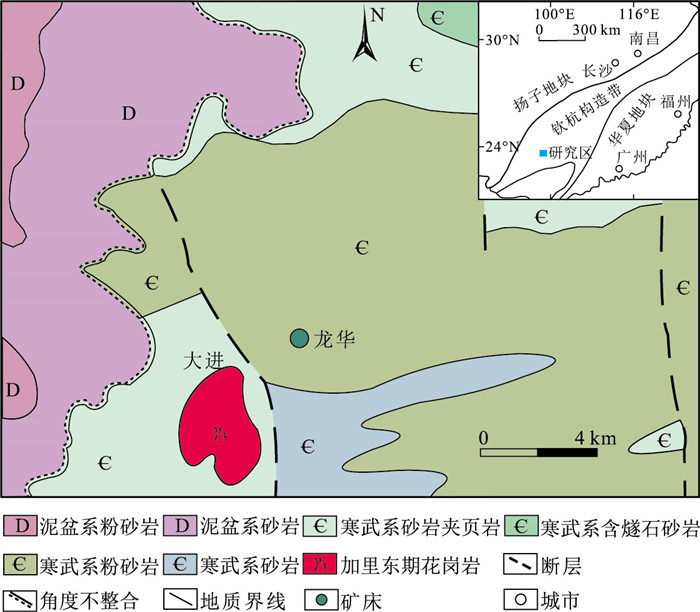
 下载:
下载:
